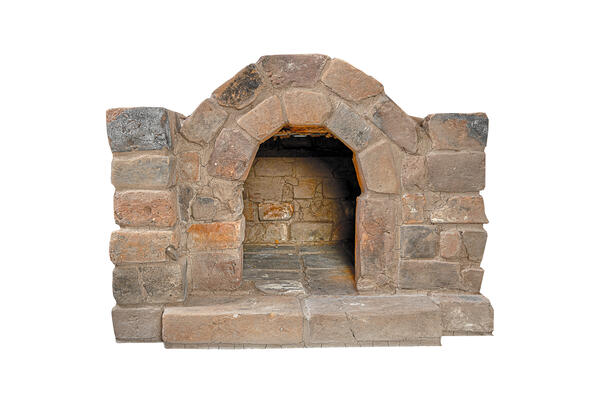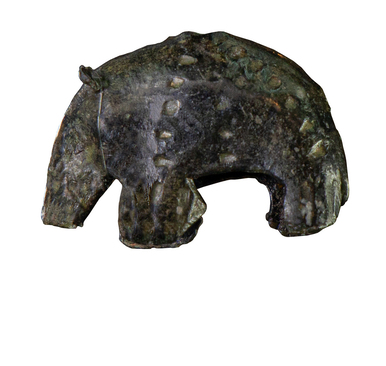The furnace was discovered in 2019 by the participants of the expedition of the Institute of Archaeology of the Russian Academy of Sciences under the leadership of Asya Engovatova and Maxim Kuritsyn. It was found on the territory of the Trinity Lavra of St. Sergius at the western monastery wall near the Carpenter’s Tower. For the exhibition, the furnace was partially reconstructed with authentic bricks of the 16th century. A similar furnace of the 16th century, discovered by the expedition of the Institute of Archeology of the Russian Academy of Sciences in the monastery in 2017, became a model for restoration.
The furnace is a small rectangular structure made of large-sized red clay bricks and their fragments. The bricks are cemented with a solution of red fireclay (refractory clay). From above, the furnace is covered with a flat arc-shaped vault, five bricks wide; the restorers reinforced it with an iron frame.
Such a furnace was heated “in black” — it did not have a chimney. The smoke came directly into the hut, gave off its heat here and left through a special window under the ceiling as it cooled down. The walls and ceiling were covered with soot, became “smoked”, so the huts were called “kurny” (smoky). In the 14th century, furnaces in kurny huts were built with a wooden chimney — “dymnitsa”. These chimneys did not extend immediately from the furnace, but a little further away.
A disadvantage of such stoves was that sparks flying out of the stove could start a fire. So the housewife had to control the intensity of the fire. Furnaces “in black” required good skills, otherwise the house could burn down, and the household could suffocate from the smoke.
The furnace from the museum collection had a furnace orifice (ustje) through which firewood was loaded and smoke came out. Traces of soot can be seen on the bricks. Earthenware dishes with food were also placed here. Fragments of two red clay pots with bolster-handles, an iron axe and a knife, as well as a bag of charred grain were found near the furnace.
The furnace was probably used for heating rooms and cooking by the builders of the first brick wall of the monastery of the 16th century. It was erected by the decree of Ivan the Terrible. The furnace is made of large-sized bricks, which were used for the construction of the monastery walls, some traces of construction lime are noticeable.
The furnace is a small rectangular structure made of large-sized red clay bricks and their fragments. The bricks are cemented with a solution of red fireclay (refractory clay). From above, the furnace is covered with a flat arc-shaped vault, five bricks wide; the restorers reinforced it with an iron frame.
Such a furnace was heated “in black” — it did not have a chimney. The smoke came directly into the hut, gave off its heat here and left through a special window under the ceiling as it cooled down. The walls and ceiling were covered with soot, became “smoked”, so the huts were called “kurny” (smoky). In the 14th century, furnaces in kurny huts were built with a wooden chimney — “dymnitsa”. These chimneys did not extend immediately from the furnace, but a little further away.
A disadvantage of such stoves was that sparks flying out of the stove could start a fire. So the housewife had to control the intensity of the fire. Furnaces “in black” required good skills, otherwise the house could burn down, and the household could suffocate from the smoke.
The furnace from the museum collection had a furnace orifice (ustje) through which firewood was loaded and smoke came out. Traces of soot can be seen on the bricks. Earthenware dishes with food were also placed here. Fragments of two red clay pots with bolster-handles, an iron axe and a knife, as well as a bag of charred grain were found near the furnace.
The furnace was probably used for heating rooms and cooking by the builders of the first brick wall of the monastery of the 16th century. It was erected by the decree of Ivan the Terrible. The furnace is made of large-sized bricks, which were used for the construction of the monastery walls, some traces of construction lime are noticeable.



